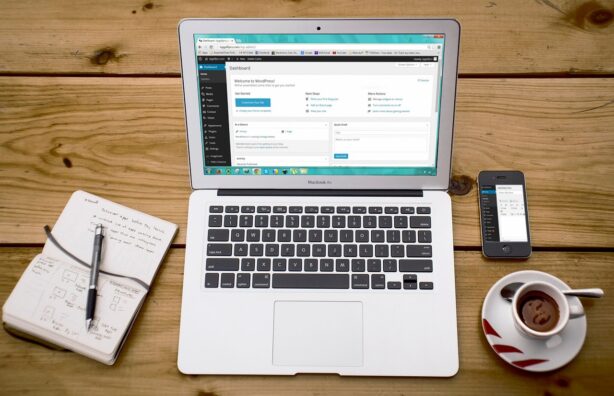Launching your own website is an exciting moment, whether you’re starting a site for your own small business, creating a new website on a niche topic, or simply want to share your thoughts in a personal blog.
But while various platforms can make publishing your new site a fairly quick and easy process, it’s important to put some thought into your site before you officially go live.

From the overall design and functionality to your strategy for marketing and SEO, having a clear plan for your website can help ensure you get the results you want.
To help you get started with your new website, follow along with this 7 step checklist for launching a website:
Define Your Purpose and Goals
The first step in launching any website is to determine exactly what the purpose of the site is going to be.
Is it to showcase your portfolio, sell products, provide information, or connect and engage with a specific audience?
Defining your website’s purpose can help you properly shape your website’s content plans, design, and functionality.
Next, it’s time to set some measurable goals that align with your site’s purpose.
Depending on why you’re launching your site, these could include building up traffic to the website, boosting sales of your products, or gaining subscribers to a forum or newsletter.
Having a well-defined purpose and goals doesn’t just help to guide your website’s development; it will also enable you to better measure success and make adjustments as needed.
Research Your Target Audience
With the purpose of your website clear in your mind, the next step is identifying and researching your target audience for the site.
Knowing who your ideal visitors are can help you choose a design that will appeal to them, as well as helping you to plan content they’ll enjoy.
Consider details like age, gender, interests and preferences. Then, research the type of websites your target audience currently visit.
With a clear idea of what your potential visitors enjoy, you’ll be in a better position to engage your readers and increase your website traffic.
Select Your Domain Name
Choosing the right domain name could be easy or difficult, depending on your website’s purpose.
For example, if you’re starting a website for your already-named small business, you’ll want a domain name that include that business name.
If you’re launching a brand new site focusing on a specific topic, on the other hand, you’ll want a name that includes that topic in some way.
If needed, take some time to brainstorm a few names that could work well for your site, and then get online to check their availability.
Choose the Right Hosting
Selecting the right hosting provider can be one of the most important steps in your checklist for launching a website.
Your hosting choice directly affects website performance, reliability, and user experience. Consider factors such as server uptime, scalability, cost, and support options.
Shared hosting is the most cost-effective option, but may lack the resources for high-traffic sites, while dedicated hosting offers more control and higher speed, but comes at a higher cost.
You can find web hosting plans to fit any budget to ensure your website runs smoothly and meets your specific needs, so take the time to look into a few different options.
You’ll also want to research the security features of any hosting company you’re considering.
Look for companies that offer regular backups, SSL certificates, and robust security measures. Good customer service and free troubleshooting in case of issues are also incredibly helpful.
Plan Your Design and User Experience
A good design is essential for a successful website, but that doesn’t have to mean hiring an expert designer to create one.
For the most part, today’s websites are clean, easy to navigate, and focused on speed.
Depending on the platform you’re using for your site, you should be able to find a variety of themes and designs that fulfill these requirements.
A must-have for your website’s design, however, is proper mobile optimization. In our busy digital world, making sure visitors can properly access your site on a smartphone or tablet is essential.
To ensure your website is user-friendly and easy to navigate, consider inviting a few friends to browse the site and test out the different elements before your launch.
Create Your Content Strategy
As important as design and user-friendliness are to the success of a website, you’ll never meet your goals without good content.
Content is the backbone of any successful website, so create a content strategy to help you decide the type of content you’ll publish, and how often it will go live.
Most websites won’t see significant traffic until they have at least fifty pieces of content, so, if possible, try to plan what your site’s first fifty posts will be.
At the same time, it’s important to prioritize quality over quantity. Make sure your content is tailored to your target audience, and answers the questions they might be asking.
Finally, make sure to also look into proper SEO strategies when creating your content, to help improve your site’s discoverability on search engines.
Maintain, Monitor, and Analyze
The work doesn’t stop after your website’s launch; it’s an ongoing process that will require maintenance, monitoring, and adjustments.
Make sure to regularly check your site’s back end to see if there are any recommended software updates, outdated plugins, or security issues.
And don’t forget about your content! Ideally, your content should be written in an “evergreen” format that will be relevant for years to come.
But, if that’s not possible, make sure to keep your posts fresh and relevant by adding new information and removing outdated material.
Finally, make sure to monitor your site’s traffic and search results with SEO tools like Google Analytics.
Use the information to refine your content strategy, look for trends in traffic, and measure the success of your SEO strategies.
By taking some time each month to monitor and maintain your website, you’ll be able to stay competitive and be more likely to achieve long-term success.

There are many different reasons that you may be considering launching your own website, and every one of them could one day lead to you managing a website that sees people visiting from around the world.
But, without properly planning the details of your website before launching, you’ll likely find that the road to reaching your goals is a harder one to walk.
Take the time to follow this checklist for launching a website, and you’ll be more likely to create the website you want and reach your goals sooner.
